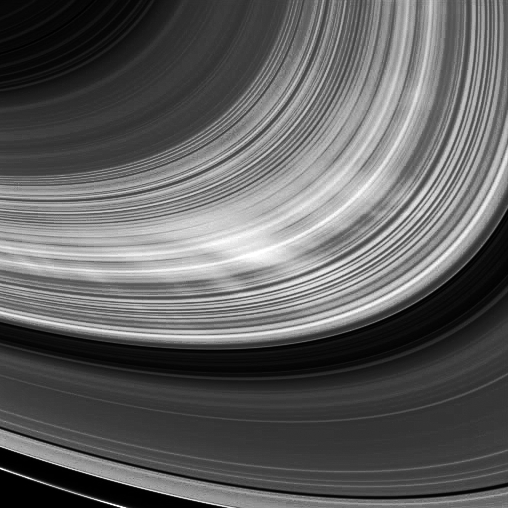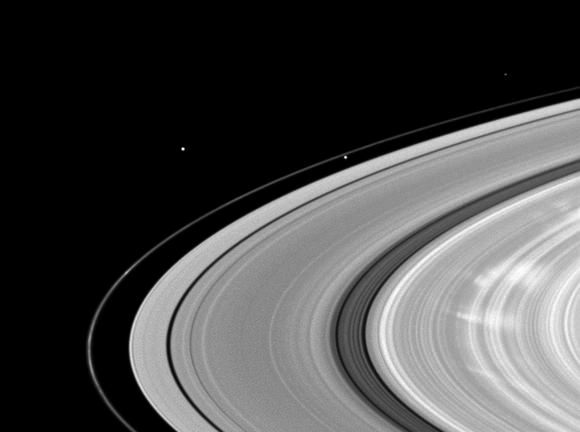[/caption]
The mysterious spokes that sometimes appear in Saturn’s largest ring, the B ring, have been unexplained. But new measurements from Cassini’s Visual Infrared Mapping spectrometer (VIMS) suggests the radial spokes that sometimes form across the ring are entirely composed of water ice. The existence of the spokes were unexpected and were first observed when the Voyager spacecraft flew by Saturn in 1980. When Cassini arrived at Saturn in 2004, the spokes were not visible, but later appeared in 2005; the VIMS instrument was not able to observe the spokes until 2008. Even with this new information, the spokes are still mysterious, as they appear to be a seasonal phenomenon and can become visible and then fade within a few hours. The process that creates and dissipates the spokes is unknown.

Early hypotheses on the spokes speculated that gravitational forces and/or electrostatic repulsion between ring particles played a role in creating the spokes. One clue was that the spokes are more commonly observed when Saturn’s rings are more nearly edge on to the Sun. Other scientists had suggested ice, but believed the spokes were composed mainly of smaller ice grains. However, the new data show a large portion of the grains are larger than expected; a micrometer or more in radius.
E. D’Aversa and his team from the Institute for Interplanetary Space Physics in Rome, Italy used the VIMS instrument on Cassini to observe the infrared spectrum emitted by these spokes on July 9, 2008. These were the first measurements of the complete reflectance spectrum of the spokes in a wide spectral range (0.35–0.51 ?m). The team said that radiative transfer modeling supports a pure water ice composition for the spoke’s grains, but their size distribution is found to be wider than previously thought.
The preliminary results showed a modal value of about 1.90 ?m (reff = 3.5 ?m, veff = 0.3) and a number density of about 0.01–0.1 grains/cm3. The researchers say the unexpected abundance of micron-sized grains in the spokes may have implications for the formation models since the energy requirement increases by at least one order of magnitude. Future observations could help constrain the size as well as shed more light on the how the spokes form, evolve and change.
Paper: The spectrum of a Saturn ring spoke from Cassini/VIMS


Well apparently there is water in more places than we thought…
That’s a long way to go for a drink.
Saturn’s rings hold a sort of fascination, for basic physical forces of gravity, maybe electromagnetism and some chemical properties of atomic matter give rise to this amazing structure.
LC
Looks to me that the real information here is the bigger than expected size of spoke particles, not their being made of ice. As far as I remember, most or all ring particles are ice. Maybe a change of title would be relevant?
Would be interesting to read implications of this relatively to spoke hypothesis, esp electrostatic repulsion.
Looks like fuel to me~ I wonder if there’s any He 3 in the area?
OMFSM! Don’t tell me the rings of Saturn have water cycles?!
I’m circularly impressed.
He3 results from charged particles or protons and deuterons streaming from the sun which interact with hydrogen in the lunar surface. Saturn is a bit out there, so He3 might not be as abundant.
LC
A second thought. If we humans start mining the rings of Saturn you can be sure we will make a damned mess of them.
LC
@ Nancy,
This is a bit belated, but you can do the symbol(s) for micrometre ( µm ) like this: &_micro_;m (omit the underscores).